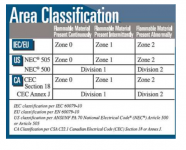Main question: Do I use the “classes”(500-503) and “zones” (505 and 506) chapters independently or in conjunction with each other? If yes the where/when and how would I use them?
I have had several Journeymen tell me yes, but when I look at the scope of 505 and 506 I can't help but think that one is just a repeat of the other. A lot of the text also says the same thing.
Can someone help me iron out the details?
I am operating out of the 2020 NEC.
"505.1 Scope.
This article covers the requirements for the zone classification system as an alternative to the division classification system covered in Article 500 for electrical and electronic equipment and wiring for all voltages in Class I, Zone 0, Zone 1, and Zone 2 hazardous (classified) locations where fire or explosion hazards may exist due to flammable gases, vapors, or liquids."
Thanks
I have had several Journeymen tell me yes, but when I look at the scope of 505 and 506 I can't help but think that one is just a repeat of the other. A lot of the text also says the same thing.
Can someone help me iron out the details?
I am operating out of the 2020 NEC.
"505.1 Scope.
This article covers the requirements for the zone classification system as an alternative to the division classification system covered in Article 500 for electrical and electronic equipment and wiring for all voltages in Class I, Zone 0, Zone 1, and Zone 2 hazardous (classified) locations where fire or explosion hazards may exist due to flammable gases, vapors, or liquids."
Thanks

